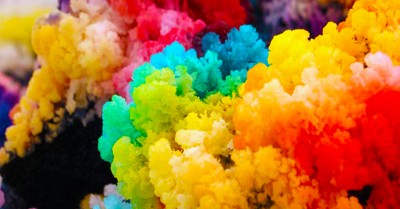Create this delicate rainbow crystal garden.
Materials:
- 2 Bottles of Bluo (available at supermarkets in laundry)
- 2 cups of Salt
- I cup of Water
- Ammonia
- Large tray or cookie sheet with sides
- Sponges
- Scissors
- Measuring cup
- Food colouring
- Eye Droppers
- Large bowl for mixing ingredients
What to do:
Day 1
- Cut the sponges into chucks and spread them around your tray.
- Mix the salt, water and 1 cup of Bluo into a large container.
- Add the mixture over all the sponges, making sure all sponges are soaked with this mixture.
Day 2
- Add 1 cup of ammonia over the sponges.
- Sprinkle 1 cup of salt over the sponges.
- Let it rest
Day 3
- Some crystals should already be growing!
- In a large bowl, mix together 1 cup of salt, 1 cup of Bluo and 1 cup of water.
- Pour this mixture once again over the sponges (the formed crystals will ruin but more will grow).
- Using an eye dropper, add food colouring over the sponges.. Use different colours to make a rainbow garden.
- Let it rest.
Over the next couple of days, the crystals will form. It's important to make sure that during this process that the rainbow garden remains undisturbed and untouched. For continually growing the garden, add small amounts of water, bluo and salt.
The Science Factor
The reason people use liquid bluing (Bluo) in crystal experiments is to make the crystal bloom into broccoli-like shapes like trees in a real garden, rather than chunks or plates. Bluing solution consists mainly of ferric ferrocyanide (commonly known as Prussian blue) and water. The Prussian blue doesn’t dissolve in the water, so it remains suspended in the liquid. This is a colloidal suspension.
At the start of a crystal garden experiment, you mix liquid bluing with salt, water and ammonia to create a watery blue sludge. Pour it over small pieces of porous material, like sponges and clay pot pieces, in a plastic container. Leave the container overnight, and by the next day, crystals should form. You keep the "garden" growing by adding more salt and more of the sludge mixture. As the water and ammonia evaporates away, the collodial particles provide seeds for the salt to produce crystals, creating the broccoli shapes.
Hints and Tips:
- Allow for plenty of air circulation to foster the bluing crystals growth.
- Ammonia is not necessary but speeds up the evaporation and crystal growth.
- Make sure the sides of your tray are high enough to contain the liquid!
- All main ingredients (salt, water, bluing, and ammonia) are measured in equal amounts. For a smaller garden use 1:1 ratio.
References:
- How To Make Crystals With Bluing, Sciencing
- Salt Crystal Garden, Ms Stewarts
- Crystal Garden, Babble Dabble Do
